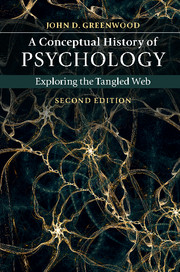Book contents
- Frontmatter
- Contents
- Preface
- 1 History, science, and psychology
- 2 Ancient Greek science and psychology
- 3 Rome and the medieval period
- 4 The scientific revolution
- 5 The Newtonian psychologists
- 6 Physiology and psychology
- 7 Theories of evolution
- 8 Psychology in Germany
- 9 Psychology in America: the early years
- 10 Functionalism, behaviorism, and mental testing
- 11 Neobehaviorism, radical behaviorism, and problems of behaviorism
- 12 The cognitive revolution
- 13 Abnormal and clinical psychology
- Epilogue: the past and future of scientific psychology
- Index
- References
9 - Psychology in America: the early years
Published online by Cambridge University Press: 05 September 2015
- Frontmatter
- Contents
- Preface
- 1 History, science, and psychology
- 2 Ancient Greek science and psychology
- 3 Rome and the medieval period
- 4 The scientific revolution
- 5 The Newtonian psychologists
- 6 Physiology and psychology
- 7 Theories of evolution
- 8 Psychology in Germany
- 9 Psychology in America: the early years
- 10 Functionalism, behaviorism, and mental testing
- 11 Neobehaviorism, radical behaviorism, and problems of behaviorism
- 12 The cognitive revolution
- 13 Abnormal and clinical psychology
- Epilogue: the past and future of scientific psychology
- Index
- References
Summary
Psychology first became an academic scientific discipline in Germany because Germany developed the modern university system that enabled Wundt and his colleagues to create an experimental psychology grounded upon the earlier success of experimental physiology. However, psychology developed faster institutionally in America than it did in Germany (Ash, 1980; Danziger, 1979). By the end of the nineteenth century, American psychology had an active professional organization, the American Psychological Association (APA), founded in 1892; journals devoted to general, experimental, and applied psychology, such as the American Journal of Psychology, Pedagogical Seminary, Psychological Review, Psychological Index, and Psychological Monographs; and a substantial academic presence within the American university system. By 1892, America had more and better laboratories than did Germany. Formal research laboratories were established at the University of Chicago, and Clark, Columbia, Cornell, Harvard, Johns Hopkins, Pennsylvania, Wisconsin, and Yale Universities; and demonstration facilities for teaching and training were available at Brown University, Catholic University of America, and Indiana, Kansas, Michigan, Nebraska, Illinois, Iowa, and Wellesley Universities (Hale, 1980; O'Donnell, 1985). By 1904, there were forty-nine laboratories, 169 members of the APA, and sixty-two institutions offering three or more courses in psychology; in addition, psychology ranked fourth in the sciences with respect to the number of PhD degrees awarded (Camfield, 1973; Miner, 1904). By 1913, the year that Watson published his behaviorist manifesto Psychology as the Behaviorist Views It, America had surpassed Germany in research publications (Cattell, 1917).
Much the same was true of the academic institutionalization of other social sciences in the early twentieth century. Émile Durkheim (1858–1917) introduced sociology in France at the end of the nineteenth century, but it made slow progress, and by 1930 there were only three chairs in sociology. Yet by 1910, there were about fifty full-time professors of sociology in America, and the subject was taught at around 400 colleges (Smith, 1997).
- Type
- Chapter
- Information
- A Conceptual History of PsychologyExploring the Tangled Web, pp. 289 - 343Publisher: Cambridge University PressPrint publication year: 2015



